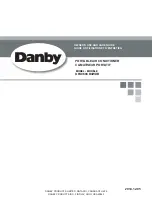
6 Preparation
Installer reference guide
21
EPGA11~ EAVH/9W
Daikin Altherma – Low temperature split
4P556070-1 – 2019.02
5.7
Setting up an external temperature
sensor
You can connect one external temperature sensor. It can measure
the indoor or outdoor ambient temperature. Daikin recommends to
use an external temperature sensor in the following cases:
Indoor ambient temperature
▪ In room thermostat control, the user interface used as room
thermostat (BRC1H) measures the indoor ambient temperature.
Therefore, the user interface used as room thermostat must be
installed on a location:
▪ Where the average temperature in the room can be detected
▪ That is NOT exposed to direct sunlight
▪ That is NOT near a heat source
▪ That is NOT affected by outside air or air draught because of,
for example, door opening/closing
▪ If this is NOT possible, Daikin recommends to connect a remote
indoor sensor (option KRCS01-1).
▪ Setup: For installation instructions, see the installation manual of
the remote indoor sensor.
▪ Configuration: Select room sensor [9.B].
Outdoor ambient temperature
▪ In the outdoor unit, the outdoor ambient temperature is measured.
Therefore, the outdoor unit must be installed on a location:
▪ At the north side of the house or at the side of the house where
the most heat emitters are located
▪ That is NOT exposed to direct sunlight
▪ If this is NOT possible, Daikin recommends to connect a remote
outdoor sensor (option EKRSCA1).
▪ Setup: For installation instructions, see the installation manual of
the remote outdoor sensor.
▪ Configuration: Select outdoor sensor [9.B].
▪ When the power saving functionality of the outdoor unit is active
(see
), the outdoor unit is turned
down to reduce standby energy losses. As a result, the outdoor
ambient temperature is NOT read out.
▪ If the desired leaving water temperature is weather dependent, the
full time outdoor temperature measurement is important. This is
another reason to install the optional outdoor ambient temperature
sensor.
INFORMATION
The external outdoor ambient sensor data (either averaged
or instantaneous) is used in the weather-dependent control
curves and in the automatic heating/cooling changeover
logic. To protect the outdoor unit, the internal sensor of the
outdoor unit is always used.
6
Preparation
6.1
Overview: Preparation
This chapter describes what you have to do and know before going
on-site.
It contains information about:
▪ Preparing the installation site
▪ Preparing the water piping
▪ Preparing the electrical wiring
6.2
Preparing the installation site
Do NOT install the unit in places often used as work place. In case
of construction works (e.g. grinding works) where a lot of dust is
created, the unit MUST be covered.
Choose an installation location with sufficient space for carrying the
unit in and out of the site.
WARNING
The appliance shall be stored in a room without
continuously operating ignition sources (example: open
flames, an operating gas appliance or an operating electric
heater).
6.2.1
Installation site requirements of the
outdoor unit
INFORMATION
Also read the precautions and requirements in the
"General safety precautions" chapter.
Mind the following spacing guidelines (see "Service space: Outdoor
unit" in the chapter "Technical data").
NOTICE
▪ Do NOT stack the units on each other.
▪ Do NOT hang the unit on a ceiling.
Strong winds (≥18 km/h) blowing against the outdoor unit’s air outlet
causes short circuit (suction of discharge air). This may result in:
▪ deterioration of the operational capacity;
▪ frequent frost acceleration in heating operation;
▪ disruption of operation due to decrease of low pressure or
increase of high pressure;
▪ a broken fan (if a strong wind blows continuously on the fan, it
may start rotating very fast, until it breaks).
It is recommended to install a baffle plate when the air outlet is
exposed to wind.
It is recommended to install the outdoor unit with the air inlet facing
the wall and NOT directly exposed to the wind.
b
a
b
c
c
a
Baffle plate
b
Prevailing wind direction
c
Air outlet
Do NOT install the unit in the following places:
▪ Sound sensitive areas (e.g. near a bedroom), so that the
operation noise will cause no trouble.
Note: If the sound is measured under actual installation
conditions, the measured value might be higher than the sound
pressure level mentioned in Sound spectrum in the data book due
to environmental noise and sound reflections.
Summary of Contents for Altherma EAVX-D9WG
Page 103: ......
















































